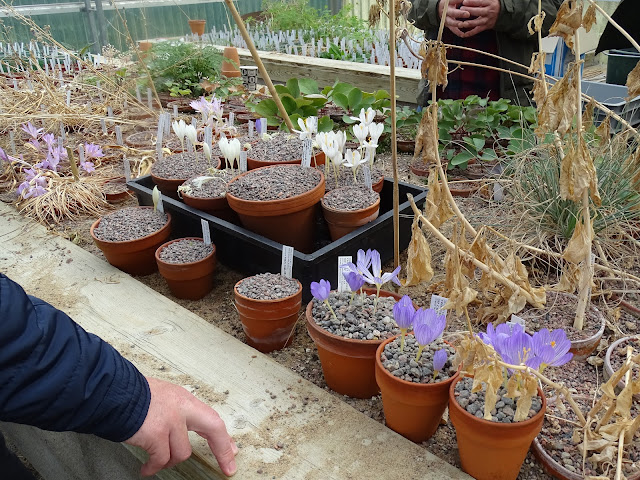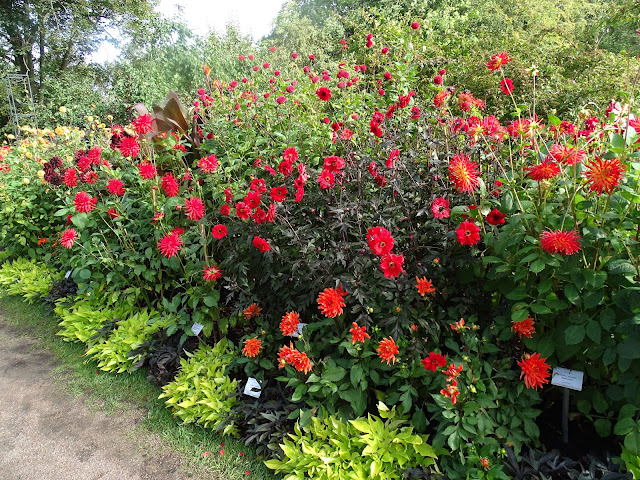 |
| Colchicum variegatum |
I begin with a colchicum, which is no accident. Sweden is on the periphery of the distribution of wild colchicums, but Gothenburg Botanic Garden is the very epicenter of Colchicum research. The largest collection of the genus in cultivation resides here, curated by Karin Persson--she and her husband Jimmy (who was senior curator at the garden) spent many decades collecting and studying Colchicums throughout their range. I had always hoped I might visit in autumn at colchicum time, and this past September I finally had my chance!

Before we delve into the bulb areas (where I always make a bee-line), I'll linger a bit on the way to enjoy the many other delightful features of this gardener's garden. Although it contains precious collections of plants, the garden is also very much a park beloved by the people of the region. There are expansive lawns, forests and ponds here and there--all very restful. The entryway (above) is typically simple and unpretentious. September is not exactly peak bloom at most North Hemisphere gardens--but Gothenburg always has MORE than enough to delight any plant nerd...I mean connoisseur!
The more you look at this amazing container, the more astonishing its scale and design. And don't you love the Grass Guru's prancing pose upper left!
And just inside you look up the hill--a wonderful tableau.
A staff horticulturist was busy primping the huge containers...
John Greenlee--an unalloyed extrovert who makes friends everywhere--naturally struck up a chat with her...
A closer look at these cloud-like planting beds near the entrance. Bold, but not ostentatious.
I take that back: this is both bold and pretty darned ostentatious.
I have admired this vista on two other occasions: it changes from year to year...
I should look up and see what annual design was behind the pond my other visits: it's always something interesting...
One of the many grand borders....
This path captures the mystery that is so wonderfully present in many Scandinavian gardens: no accident Ingmar Bergman came from here!
Here we are in the bulb house: Of course, March, April and May are when this is blazing--but there are a few other plants in here as well: in September the Acantholimons (one of my loves) were in full seed: I was intrigued to see which species they had...
They're quite different from one another..
And of course there were lots of Colchicums!

I always had a hunch we were responsible for getting this around the U.S.A.--but it was introduced by Henrik Zetterlund who collected it in Pakistan in the early 1980's: First labeled
Dictyolion macrorhabdos, it morphed into
Aeoniopsis cabulica and now passes as Bukiniczia cabulica..
They once had the true
Dictyolimon in the alpine houses, but no longer...
Us plant nerds even love to just look at the labels by themselves!
Of course the plants growing here have a great deal of interest for us in Colorado: these are plants we can grow without watering.
I was amused by the sunflower. Gothenburg has a sense of humor...It didn't escape me (nor likely them) that
Helianthemum annuus (like all the North Temperate Cereals and most vegetables) is as much a child of the steppes as the bulbs around it.
An acantholimon to die for: I have admired this in the wild, at Wisley and Wurzburg. We have it in Denver too, but not yet so well grown.
A stuning mat of the silver bindweed: NOT a weed, believe me. I thought we grew it well..
We were a merry company, all there thanks to Peter Korn and Julia Andersson whose Kinta Garden sponsored the lectures that brought us here. The
Dionysia greenhouse is like arriving at Mecca for a devout Muslim...
I was intrigued so many had random flowers: apparently they always do..
You are not a rock gardener if you haven't killed a few of these. Many die if you look at them askance. These are among the summits of the art, and Gothenburg is one of the premier showcases for them.
I show the label of that soboliferous Linaria--a genus one doesn't usually think of as choice.
L. alpina nearly swallowed up my garden once.
Greenhouse after greenhouse, one more full of treasures than the next, all in perfect condition and I've never seen a weed. All plants you will rarely see anywhere else--some perhaps at Kew, some at Edinburgh, others at Munich or Wurzburg or one of a handful of other great European gardens. Very few American gardens even dream of trying this sort of collection. Alas.
Lots of random pix in the alpine houses--we were delighted and enjoying each others company as well as the collections.
The wonderful autumn snowdrop about to bloom!
And the sexiest of Veratrums,
V. fimbriatum from California.
A cluster of autumnal alliums, for my friend Mark, who will doubtless read this blog.
On and on it goes...
Yet another greenhouse with crocus in pots--the autumn species putting on a show.
Even a few Cacti! (they have many more in a succulent greenhouse of course)
IO could spend days here, drooling over the labels and the little gems!
I had a mild shock seeing this: one of the plants I have most yearned o grow--and they have a whole row of them (
Tchihatchewia isitadea). Gothenburg is very generous: we are apt to get seed if it sets: their
Index Seminum is generally regarded as one of the very best of any garden.
Here I am utterly delighted to be between Henrik Zetterlund (on my right) who has done so much to create the collections here. On my left is Johan Nilson, who oversees much of the alpine collections from day to day: two of the premier horticulturists in the world. No wonder I'm beaming!
And there is more...
And now the colchicums! Mecca indeed! THE place to be if you love bulbs in September...
Oh the hours one could spend worshiping, admiring, and learning.
Each plant labeled, researched, unique and with a pedigree going back decades sometimes. All part of the monograph. A large percentage of these represent taxa new to science that were described here. Not many gardens boast collections like this.
Even the dormant pots are fascinating to the likes of me...
A bulb with a swollen stem like our Western
Eriogonum inflatum: I'll bet it's "inflatum" as well...ain't Nature grand and so subtly repetitious.
On and on they go...with military precision The treasures of the temperate world!
I love the thistle in the middle of the treasures. It is apt o be a treasure too.
Some yummy ferns...
And a bevy of
Dicentra...
Finally we venture forth into the gardens. They even have beds dedicated to cultivated dahlias!
They were in prime form when we were there, and with a dahlia fancier in my house I had to photograph them!
Cobaea scandens, one of my all time favorite tender vines looking great...
And we finish part 1 with a mass of scarlet dahlias: we've barely touched the Garden outside the alpine collections. Many other classic tropical and Mediterranean greenhouses I didn't even see this trip, but I spent a long time in the woodland gardens, the vast rock garden and elsewhere--and if I can only trim down my hundreds of pictures, perhaps I shall share these with you too. My suggestion, just pack your bags and go there! It's worth it whenever you might visit, believe me!













































































